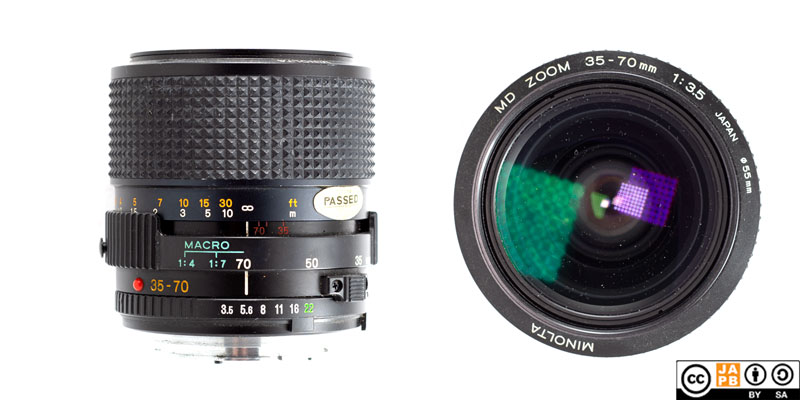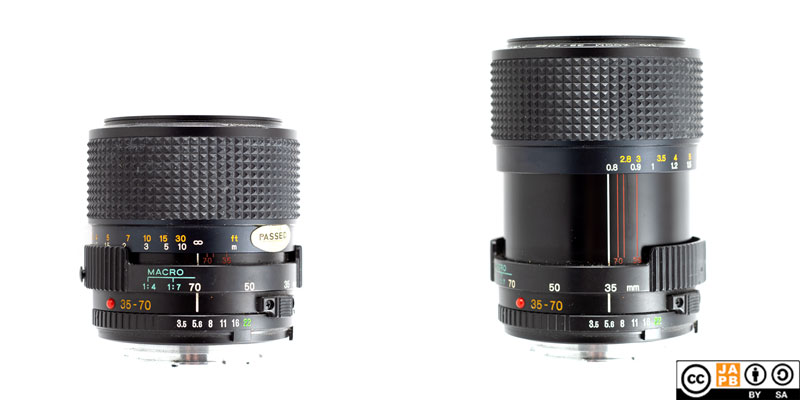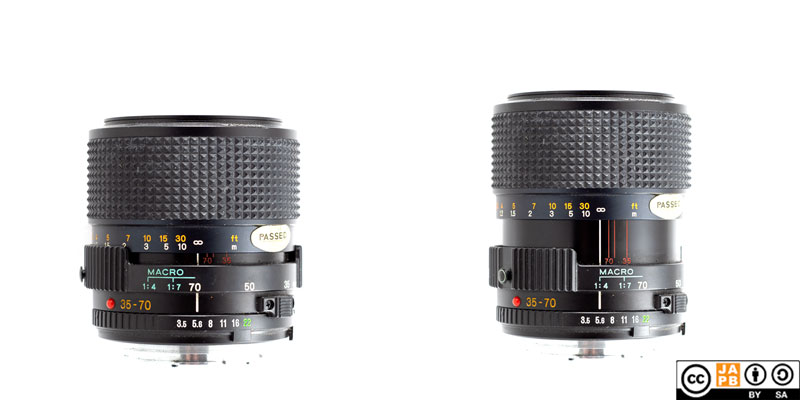Pekka Buttler, 12/2023

Specifications
The table below summarizes the lens’ key specifications (Measurements based on pictured sample):
| Brand: | Minolta | Lens name | MD ZOOM 35–70mm 1:3.5 |
| Focal length(s) 1 | 35–70 mm | Angle-of-view 2 | 62 ° – 32 ° |
| Maximum Aperture | f/3.5 | In Production | 1983–???? |
| Lens mounts | Minolta SR | Subfamily (if applicable) | MD (III) |
| Length 3 | 68,8 mm | Diameter 4 | 67,3 mm |
| Filter ring diameter | 55 mm | Weight | 369 grams |
| Lens element count | 8 | Lens group count | 7 |
| Aperture blades (S/R/C) 5 | 7 S | Focus throw | 90 ° |
| Minimum focusing distance | 80 cms | Maximum magnification | 1:4 |
| Has manual aperture ring | YES | Has Manual focus ring | YES |
| Aperture mechanism type | Automatic | Aperture click stops 6 | 3.5-5.6•8•11•16-22 |
Further notes:
• This is the third (and last) 35–70 mm f/3.5 zoom lens that Minolta introduced for the Minolta SR mount. Only two years after the introduction of this lens (in 1985) Minolta unveiled the Minolta 7000 autofocus camera which featured the new Minolta A (Sony A) mount. Since that, Minolta’s emphasis was on developing autofocus SLRs. See more under ‘versions‘
• Common wisdom is, that this (III) version is optically superior to the (II) and (I) versions, which is quite something considering that Leica considered the (I) version good enough to rebrand it the Leica 35-70mm f3.5 Vario-Elmar-R.
• This lens has a macro mode (usable at the 70 mm zoom setting), that allows an impressive level of close-up photography. When zoomed to 70 mm, you can enter the macro mode by pressing a button on the left of the zoom ring and twisting the zoom ring beyond 70 mm. The lens lengthens when entering the macro mode.
• The lens extends significantly when zooming out (it is at its shortest at 70 mm), and lengthens a bit when focusing towards MFD. The filter ring rotates during focusing.
• The lens is not parfocal, but not extremely far from it.
• Even so, in 1994 Minolta introduced one more manual focus 35–70 mm zoom, but this time with a variable aperture (f/3.5–4.8)


Versions
Minolta manufactured 3 versions of the MD 35-70 mm f/3.5 lens
• (Mk1) (1978–1981) “MD ZOOM ROKKOR” (MDII), 1 m MFD, 365 grams, No macro mode.
• (Mk2) (1981–1983) “MD ZOOM” (MDIII), 1 m MFD, 355 grams, No macro mode.
• (Mk3) (1983–????) “MD ZOOM” (MDIII), 0,8 m MFD, 365 grams, Macro mode.
Adapting
This lens cannot be used natively on any current SLR or dSLRs. To use it in its native environment, you will need a Minolta SR (SR/MC/MD/X-600) film camera. Luckily these are quite easy to find. To use the lens’ full designed capabilities, a Minolta MD-compatible body (any Minolta SR body launched after 1977) is most recommended..
Thanks to being a fully manual lens (manual aperture, manual focus), the lens can be adapted to all mirrorless cameras using a suitable adapter. Moreover, a simple ‘dumb adapter’ will do the job perfectly. Thanks to the popularity of the Minolta SR mount, the availability of adapters to all mirrorless mounts can be taken for granted, on the other hand, specialist adapters (speed boosters, helicoid adapters, tilt/shift adapters) are not available for all mirrorless mounts, but daisy-chaining adapters (e.g. Minolta SR -> Canon EF; Canon EF –> mirrorless) can offer a work-around.
Using Minolta SR mount lenses on dSLRs is also be an option, but it is not trouble-free due to that the Minolta SR mount’s flange focal distance is shorter than that of any dSLR mount (technically with the exception of Olympus’ four thirds mount). Hence, any attempt at adapting Minolta SR lenses must rely on an adapter that uses corrective optics to allow infinity focus. However, such adapters are readily available.
History of Minolta
Minolta exited the camera business in 2006 and sold its remaining photographic assets to Sony. The 50 years before that ignominious date tell a very different story: one of a Japanese optics and innovation powerhouse that has interesting links to Germany – not Nazi Germany, but both pre WWII Germany as well as postwar West Germany. Read more in the Minolta company profile.
Footnotes
- Focal length is (unless stated otherwise) given in absolute terms, and not in Full-frame equivalent. For an understanding of whether the lens is wide/tele, see ‘Angle-of-view’. ↩︎
- Picture angle is given in degrees (based on manufacturers’ specs) and concerns the diagonal picture angle. Rule of thumb:
> 90 ° ==> Ultra-wide-angle
70–90 ° ==> Wide-angle
50–70 ° ==> Moderate wide-angle
40–50 ° ==> ‘Standard’ or ‘normal’ lens
20–40 ° ==> Short tele lens
10-20 ° ==> Tele lens
5-10 ° ==> Long tele lens
< 5 ° ==> Ultra-tele lens ↩︎ - Length is given from the mount flange to the front of lens at infinity. ↩︎
- Diameter excludes protrusions such as rabbit ears or stop-down levers. ↩︎
- S=straight; R=rounded; C=(almost)circular at all apertures. ↩︎
- Numbers equal aperture values on aperture ring; • intermediate click; – no intermediate click. ↩︎